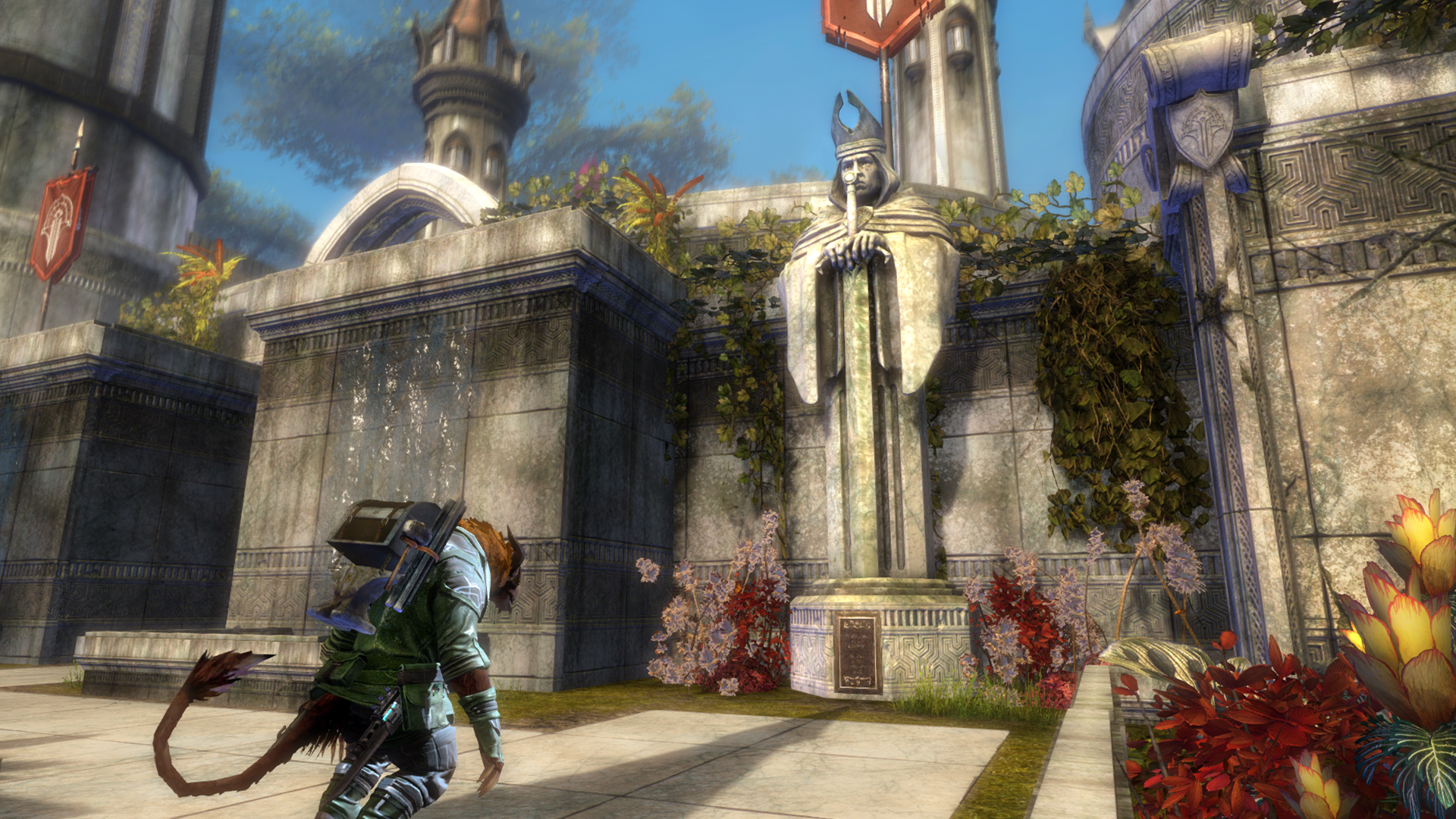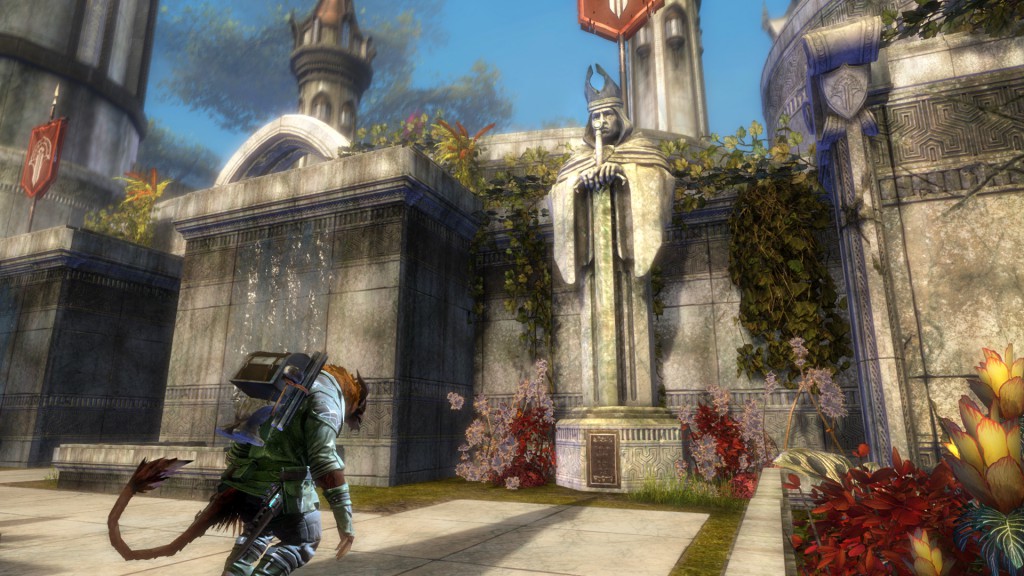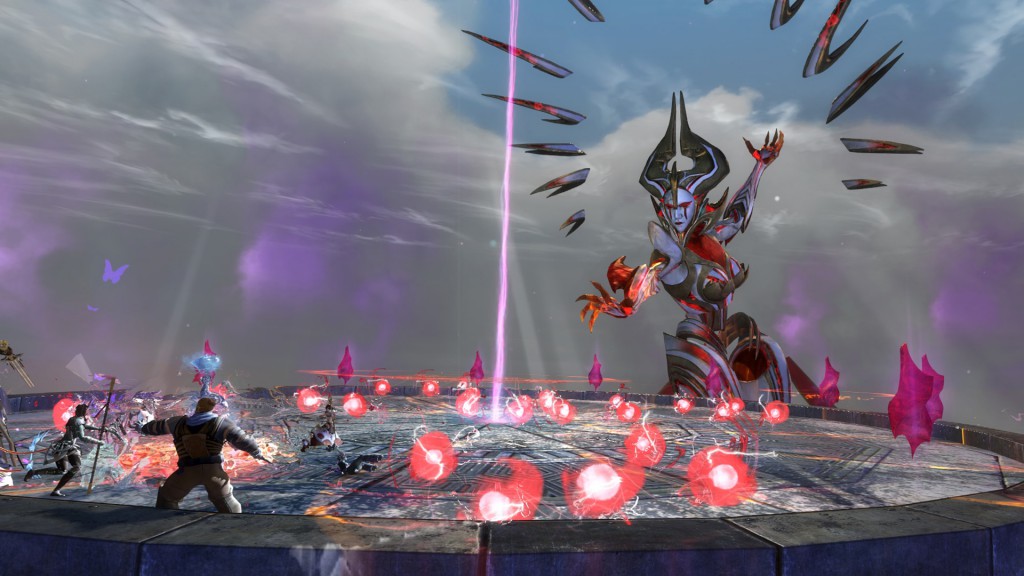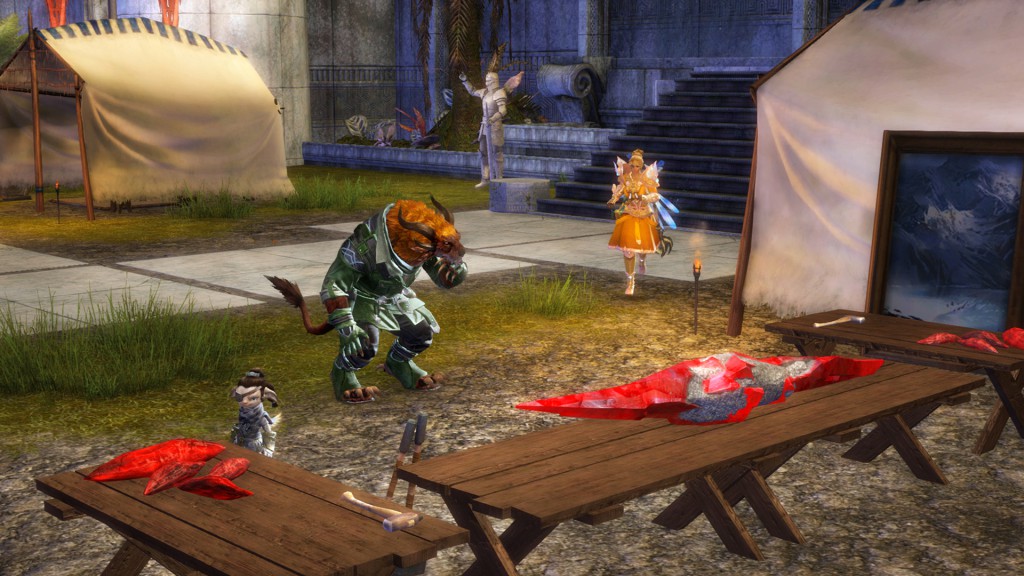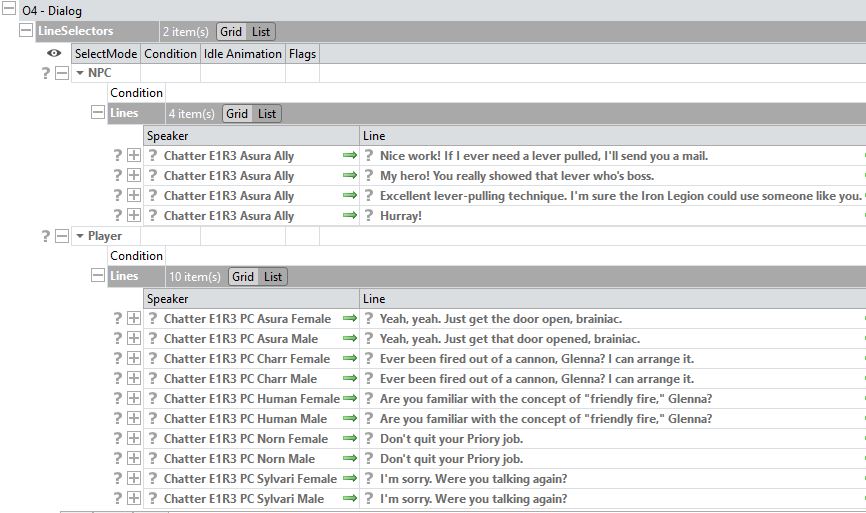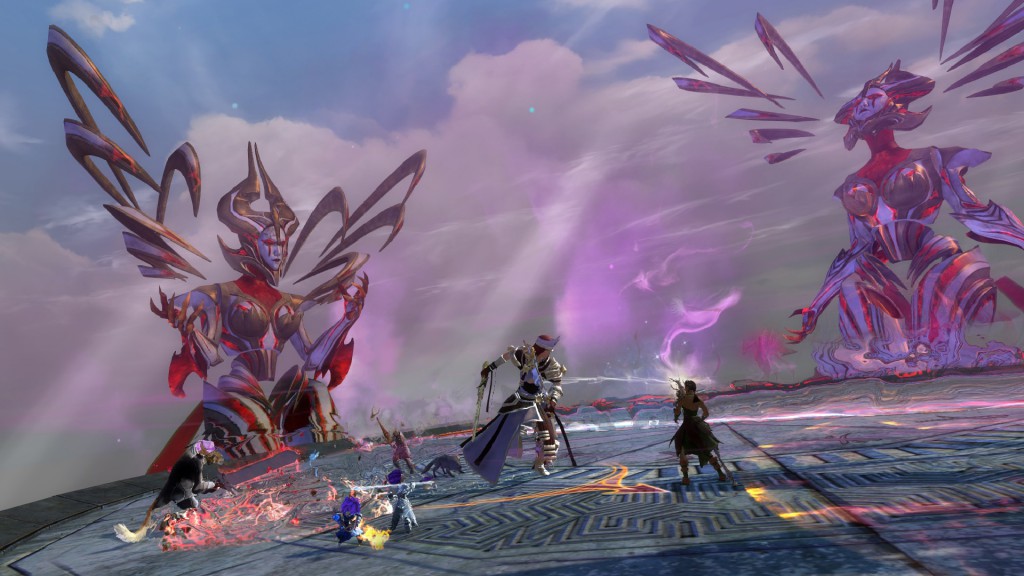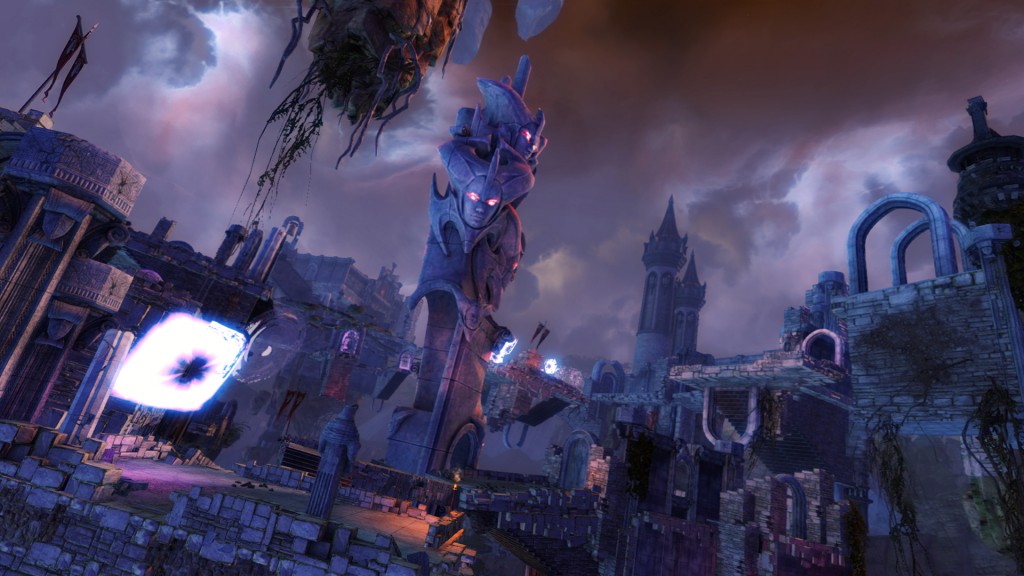Hello, friendos! I’m Teddy Nguyen, one of the designers on raids.
For today’s blog, we’re trying something a little different. Since we’re doing a retrospective of raids in Guild Wars 2, we thought it’d be fun to bring together all the designers who have worked on raids thus far for their perspective on different aspects of raiding. Each section will be headed by the writer’s name. We’ve also included our twitter handles at the end if you’d like to keep up with us outside the studio.
First, a few words from our raid director, Steven Waller.
Steven Waller
Fellow Tyrians,
In 2015, we announced that Guild Wars 2: Heart of Thorns™ would provide players the ultimate challenge with the introduction of raids. To meet that challenge as developers, we set out with a vision to create encounters that would put raiders’ skills and coordination to the test using our groundbreaking combat and dynamic event systems. In a way, our team was embarking on an adventure of our own.
And what an adventure it’s been! Since the announcement, we shipped two formidable raid wings, introduced the Raid Lobby and Special Forces Training Area to allow players to gather and train, and added the Raids category to the Looking for Group tool to help daring heroes organize themselves against the threats that await. So now, with the arrival of the third wing, Stronghold of the Faithful, we thought it would be great to look back on the journey we took as a team and share some lessons learned along the way.
Byron Miller
Hey, I’m Byron, raid designer and internal raid leader. I was also responsible for the Lion’s Arch Aerodrome raid lobby.
Right now I’m on live, standing on Mount ArenaNet in the Lion’s Arch Aerodrome, and riding a wave of positive feels after killing Matthias for the first time with one of our all-ArenaNet Live Raid Teams.
Right now, my salt levels are at an all-time low.
Right now, I love raiding.
There are times, though, when I don’t love raiding. Sometimes raiding gets to me. Sometimes we wipe three attempts in a row because a necro epidemic’d the slubling. Sometimes someone who will remain nameless (me) fat-fingers elementalist staff fire 4 off a cannon platform during Sabetha and plummets to his death and has to spend the next 80% of the fight slowly rotating his camera around his lifeless corpse. It’s not all slippery slublings and Matthias kills in the end. All of those moments build up over time, and when the stakes are high and the Eternal is on the line, even the small things can feel incredibly draining. It’s at these times that it’s important to look back and identify when it went right: that moment when you first broke down a wall at Gorseval and everyone on the team made it to the updraft alive; that moment when your returning elementalist dropped out of their glider to cast Mist Form the instant before Flame Wall hit him; that moment when, after weeks of struggling, your raid just clicked and you got that first kill. It’s the sum of all those experiences—enhanced by the bittersweet memory of mistakes and 1% wipes—that make raiding a sublime experience and one we strive to provide to you, our players, every time we set out to build a raid.
Playing our content in a test environment is incredibly similar to raiding on live, except the focus isn’t as heavily on the player’s execution as it is on the player’s interaction with the content. Testing, especially as a group, gives us an environment where execution isn’t our main focus—an environment where we can break apart the encounter and examine it on a moment-to-moment basis. If you were to listen in, the most common phrase you’d overhear would probably be something along the lines of, “All right, everyone die. Just surrender already. My god.” Just like on live, dying is a part of learning. Testing gives us an opportunity to talk about what we just experienced, how it felt, and whether it achieved the goals that were set by the design. We talk about messaging, the push and pull of the encounter, and the tensions that we feel the encounter places on the different professions. We talk a lot about what we like, what we think needs to be improved, and most importantly, what didn’t work. And you know, sometimes that can be just as draining as wiping over and over at 1% on a boss we should have killed weeks ago. But ultimately, these interactions lead to something. We play week to week, watching as our comments and feedback get worked into the encounters. Messaging gets clarified, the cadence of the fight becomes more natural, and the profession roles become second nature.
Running a raid and developing a raid aren’t altogether too different, it turns out. There is iteration, there is failure, there is feedback, and ultimately there is success. You start with very little, and through a shared set of tribulations, you and your team emerge on the other side, stronger and wiser than you were when you began. It’s a blast to do, and the feeling we get when we see the videos, read the whispers and the mails, and hear the voices of the Clowns is just as invigorating as the first time you kill a White Mantle abomination.
PS: Full disclosure—I am a necro/ele main, and I’ve made all the mistakes—and more—that I’ve highlighted in this post.
Bobby Stein
I’m Bobby Stein, a narrative lead at ArenaNet and the primary story guy for raids. I work with the team to flesh out the story and present it in ways that harmonize with gameplay and art.
We looked at raids as an exciting narrative challenge, a place where we could answer some lingering questions and further explore some stories we’ve wanted to tell for years. Since we were effectively coming up with a new content type for our game, we had to experiment with different ways of imparting story that piqued players’ curiosities while also respecting their time. We went with a two-tiered narrative design where the core story—internally referred to as “the spine” or through line—occurs naturally and automatically during gameplay. This includes key plot elements that make for a logical end-to-end experience. On top of that, we added the “meat,” which includes some optional discoverables that are meant to reward exploration, fill in some lore and story details, and provide enough context to allow players to speculate on where things are going. To tie it all together, we focused on the party dynamic to make the experience feel a bit different than elsewhere in the game.
Raids aren’t about saving the world, being the “Chosen One,” or waging all-out war with a hundred people at your side. They’re about ten of the baddest mercenaries venturing deep into unknown territory and overcoming nigh impossible odds. Inside, you discover unexpected enemies, sophisticated mechanics, and the threads of a deeper, darker narrative. With all this in mind, we knew we had to shift our storytelling methods in tone, mood, and delivery to match the new setting.
Unlike in the Personal Story—where the narrative belongs to the instance owner—in raids, every member of your squad is a potential leader. Be in the right place at the right time, and you’ll take charge of the situation, comment on an important clue, or taunt an adversary. Play the raids multiple times, and you’ll encounter new lines of dialog as you go. Sift through your chat log, and you just might uncover new plot details or hints of what’s to come. And if you’re feeling adventurous, go ahead and take a detour between fights. We’ve stashed all kinds of secrets to feed your curiosity and get you speculating. It’s a balance of in-the-moment and downtime storytelling that doesn’t require you to dig deep but rewards those who do.
We’ve experimented with each release, pushing our dialog systems a bit harder and trying to find ways to better communicate mechanics while also giving characters a bit more personality. We started writing more line variants that take into account a player’s race or profession choice, so depending on your party’s composition, you might hear a different reaction to the situation (or a snarky comment about your enemy’s abilities). With each release, we plan to merge the various game elements in new ways to craft a richer experience that lets your mind wander.
So keep on theorycrafting. Our next destination may surprise you.
Teddy Nguyen
I’m Teddy, raid designer responsible for parts of the upcoming Stronghold of the Faithful raid. I’m excited to chat with you a bit about raiding achievements.
I’m going to let you in on a little secret. The key to making a good achievement is starting with a clever pun or pop-culture reference. The rest of the achievement designs itself.
In all seriousness, strong achievements are a key part of the raiding experience. Raiding at its core is about demonstrating your skill and showing off. What better way to do it than completing a particularly difficult achievement that only an elite few would even contemplate trying? At their best, raid achievements task you and your friends with rising up and above the already daunting challenge of raid encounters to pull off something truly impressive. They push you to achieve. See the Slippery Slubling achievement for an example of this. In short, achievements are one avenue by which you can show off how good you are at raiding.
That isn’t to say every achievement in our raids is an excruciating test of mind and mettle. We try to design a diverse set of achievements, ranging from simple lore and exploring to the more masochistic challenge-mode tasks. Even for raiders not looking to push the limits of what they can do, achievements can be a useful marker of progress and completion.
As we move forward with raiding, look forward to seeing more achievements from both ends of the spectrum. If you fancy yourself a good player, here’s your chance to show it.
Jason Reynolds
Hi, I’m Jason Reynolds, designer for Spirit Vale and design lead for Stronghold of the Faithful.
It goes without saying that encounter design is the skeleton, meat, and soul of what makes raid events what they are. You can’t have an encounter without designing the encounter. Duh. What’s interesting about the process is that designs tend to twist and turn in directions that were not intended—or even considered—at the start. When designing on paper, boss attacks and intended player strategies are seemingly easily plotted. Once you move into a 3-D space where the event is in a prototype playable stage and you get players who aren’t you beating on it, those brilliant designs and predictions tend to—POOF—hit the proverbial fan. With a complex combat system like Guild Wars 2 cultivates, that result is often exacerbated.
One of the biggest challenges with this job is being able to rapidly iterate. Another is to be able to decipher what “this isn’t fun” actually means. Sure, being able to peer into the future is a highly valued skill. And it is absolutely helpful when a player can intricately detail what it is that is causing them to not enjoy an encounter. Those two things rarely happen. When evolving an encounter, it is critical to keep in mind the spirit and emotions that you want conveyed while you rapidly iterate on mechanics to improve them. See what works, and toss what doesn’t. Marrying yourself to a mechanic often stymies that process, so being comfortable with throwing something away is critical. Encounter design is an ever-changing, highly organic process; the sooner that is embraced, the better for everyone.
Crystal Reid
Hi, I’m Crystal Raid Reid, Raid Design Lead. I was responsible for Spirit Vale and Salvation Pass, and I want to talk about how we learn from every release.
The raids team is constantly learning. We spend a lot of time talking about things we felt went well and things that didn’t. This is both from an internal production point of view and by asking ourselves, “What did the players think of this encounter?” There are always lessons to be learned from each release.
From a preproduction standpoint, one of the things we’ve learned is to have less individual responsibility checks on earlier boss fights and make the gameplay more group focused. While the Slothasor encounter remains a favorite, it has also seen the lowest success rate of all the current raid bosses; it’s simply too easy for a single player to wipe the raid. Going forward, we are trying to focus on more group-orientated gameplay for intro bosses and then slowly ramp up the individual checks over time.
After raids shipped and ran free in the wild, we began to watch player feedback. Putting the first raid entry in Verdant Brink wasn’t as successful as we thought it would be. While it was great that it tied the raid to a real-world location, it was definitely intrusive for players trying to run the meta-events. Adding the Raid Lobby and adding the raids category to LFG were both huge boons to assist.
Going forward, you can expect to see us fine-tuning the content we create for you in raids and having many postmortem discussions on how we can make them better.
As we come to the end of delivering the final of the three raid wings that we promised with Guild Wars 2: Heart of Thorns, it’s funny to imagine the process of developing them as something similar to playing them in-game. Our team of diverse professions came together with a common goal. We had a strategy, but at times we wiped. So we kept working together. We rose up to meet the challenge and delivered encounters that we hope you enjoy as much as we loved making them. And while this is not the end, we all realize that this was at least the end of the beginning.
We’ll see you in-game!
Byron—@Winter_Minute
Teddy—@PaschBlue
Jason—@JasonArrr
Bobby—@BobbyStein

